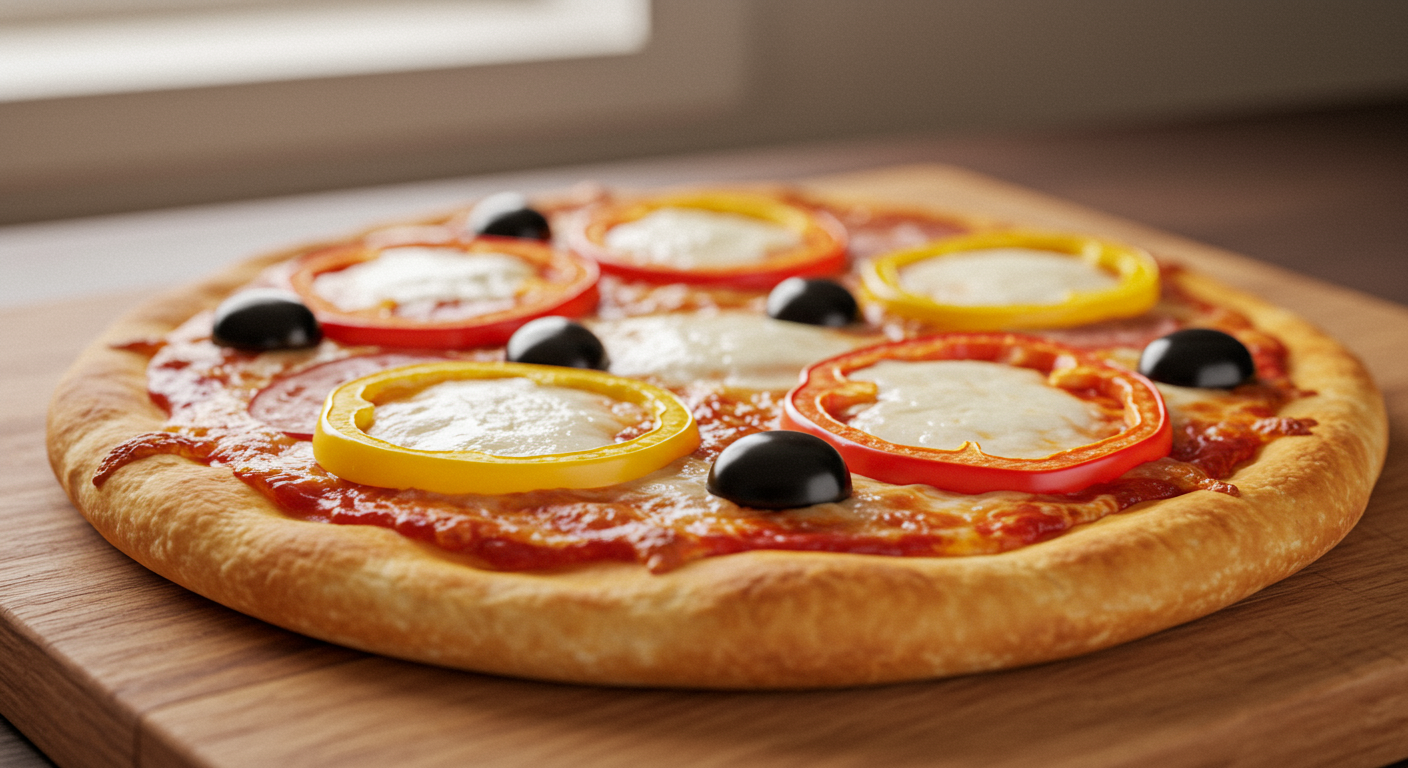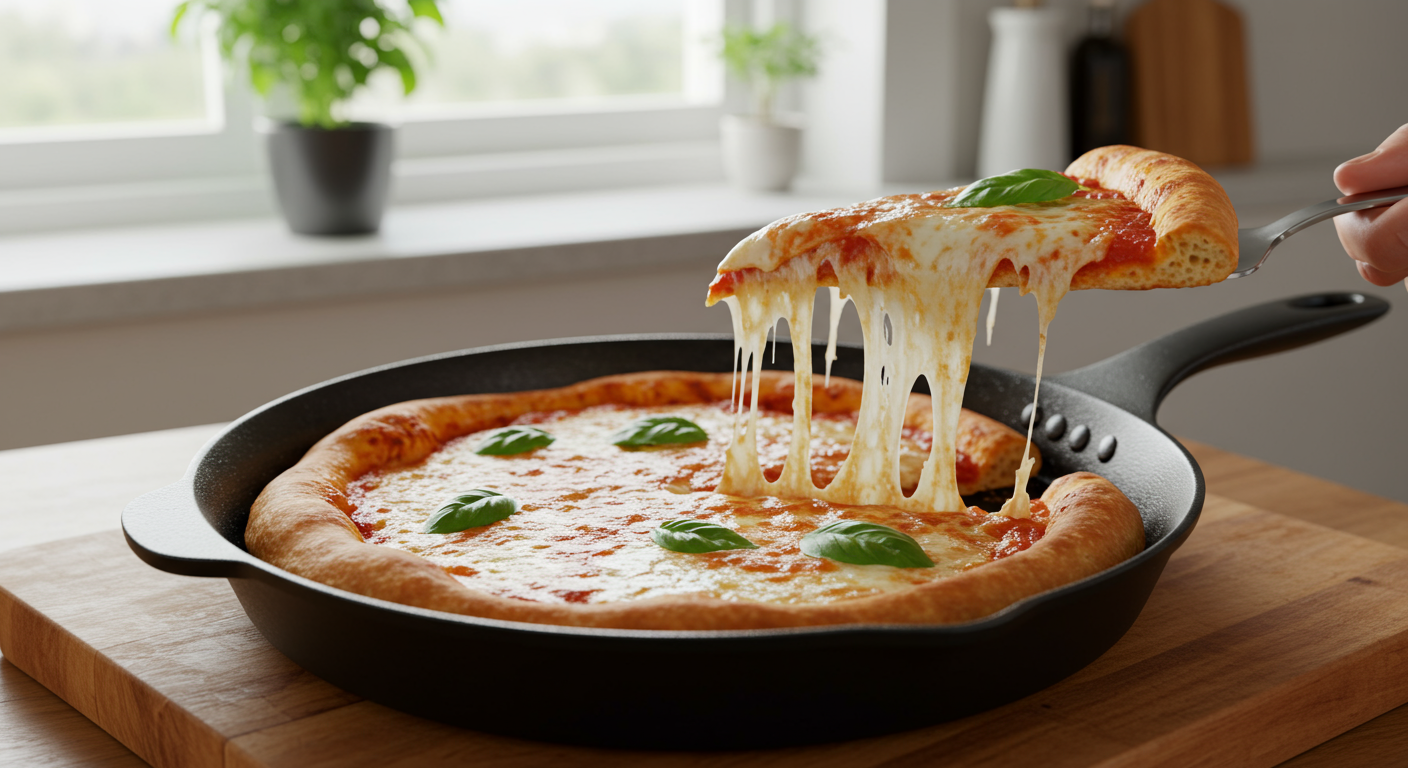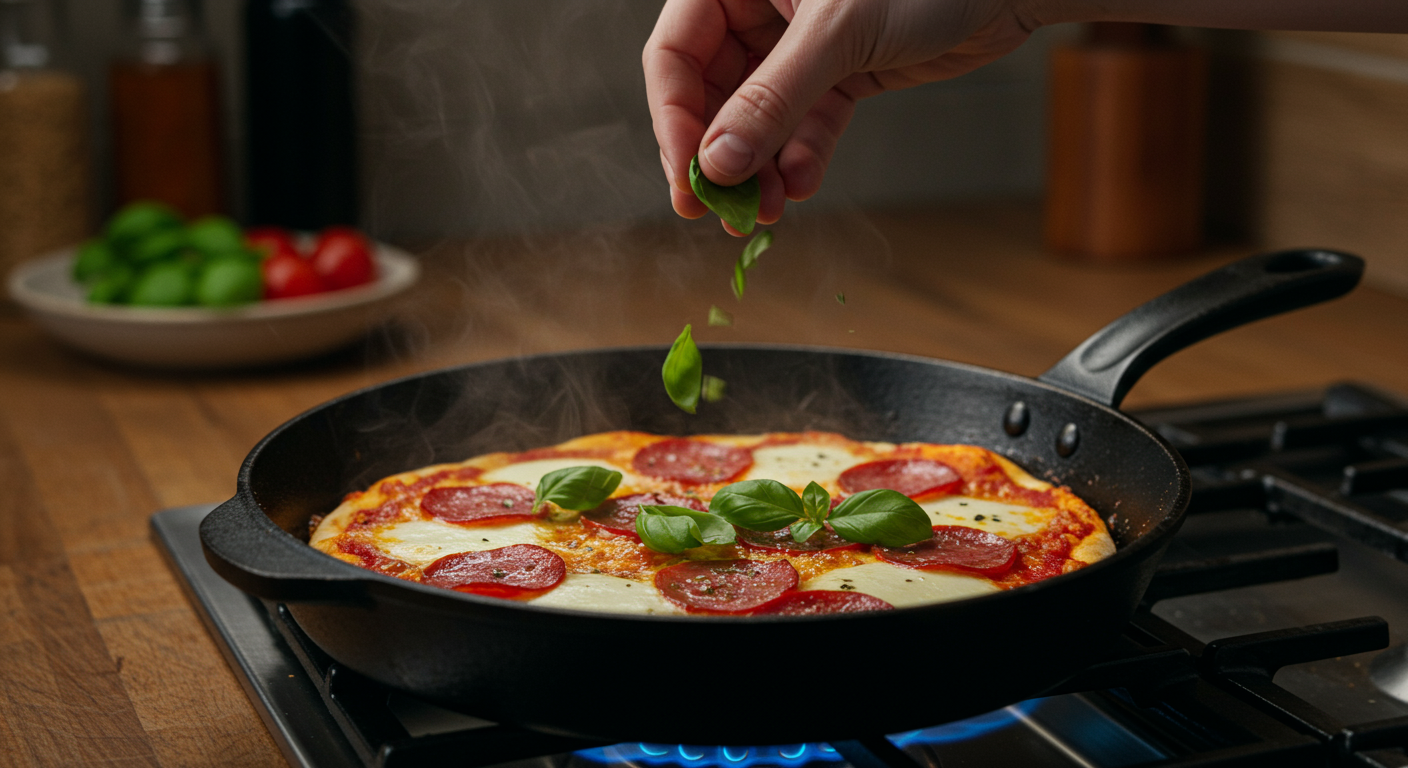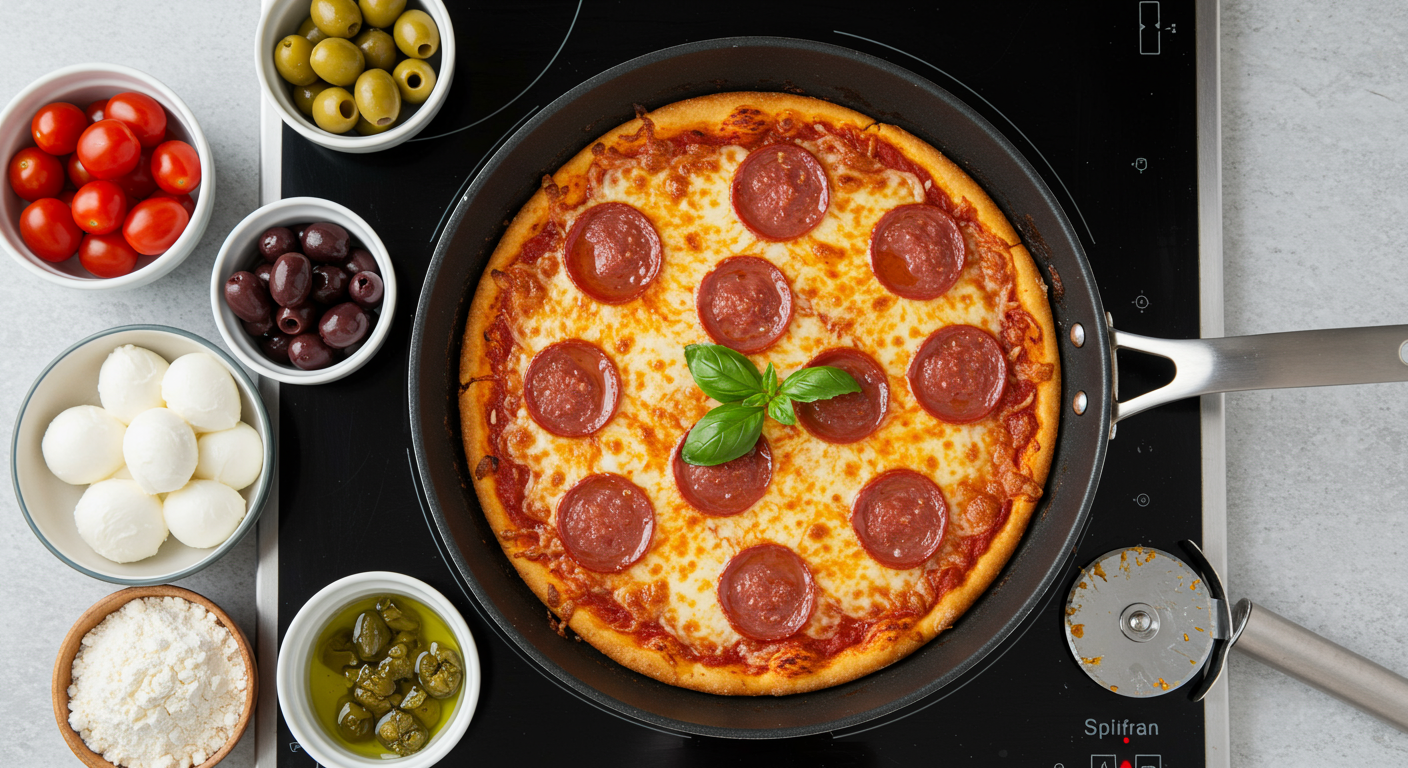Are you craving a hot, cheesy pizza but don’t have an oven? No problem! In this ultimate guide, we’ll show you how to make mouthwatering pizza at home without an oven. Whether you’re in a dorm room, a small apartment, or just dealing with a broken oven, this stovetop pizza recipe is a game-changer. It’s simple, customizable, and delivers that perfect crispy crust with gooey toppings – all using just a pan and your stovetop.
Making pizza at home without an oven isn’t just convenient; it’s also budget-friendly and healthier than takeout. You control the ingredients, avoiding preservatives and excess sodium. Plus, it’s a fun activity for families or date nights. In this post, we’ll dive into the history of pizza, a detailed recipe for a classic Margherita-style pizza (with variations), step-by-step instructions, pro tips, and answers to common questions. By the end, you’ll be a stovetop pizza pro!
Why go oven-free? Traditional ovens can be energy hogs and heat up your kitchen, especially in summer. Stovetop methods use less electricity and cook faster – we’re talking pizza ready in under 30 minutes! This recipe serves 2-4 people and is beginner-friendly. Let’s get started!
A Brief History of Pizza: From Ancient Roots to Modern Twists
Pizza has a rich history that dates back thousands of years, long before ovens became a household staple. The concept of flatbreads topped with ingredients originated in ancient civilizations. The Egyptians, Greeks, and Romans all had versions of what we’d call pizza today. For instance, the Greeks baked “plakous,” a flatbread topped with oils, herbs, and cheese, while the Romans enjoyed “placenta,” a similar dish.
The modern pizza as we know it evolved in Naples, Italy, in the 18th century. Street vendors sold flatbreads to the working poor, who needed cheap, portable food. In 1889, Queen Margherita of Savoy visited Naples and tried a pizza topped with tomatoes, mozzarella, and basil – colors representing the Italian flag. This became the Margherita pizza, a timeless classic.
But pizza without an oven? That’s not a new idea. Before wood-fired ovens were common, people cooked flatbreads on hot stones or over open flames. In rural areas of Italy and other parts of the world, stovetop or pan-fried versions were everyday meals. Immigrants brought these techniques to America in the late 19th century, where pizza exploded in popularity after World War II.
Today, with global fusion, pizza has endless variations – from Indian naan-based pizzas to Mexican tortilla versions. The no-oven method we’re exploring here draws from these humble beginnings, proving that great pizza doesn’t require fancy equipment. It’s a nod to resourcefulness: during wartime shortages or in developing countries, people have always adapted recipes to what they have on hand.
In the digital age, social media has popularized oven-free hacks. TikTok and YouTube are flooded with videos of air fryer pizzas or microwave versions, but the stovetop method reigns supreme for authenticity. It’s versatile for dietary needs too – gluten-free, vegan, or low-carb adaptations are easy. As we face rising energy costs and climate concerns, oven-free cooking is more relevant than ever. This recipe honors pizza’s history while making it accessible for everyone.
Ingredients for Stovetop Pizza at Home
Gathering the right ingredients is key to a successful no-oven pizza. This recipe makes two 10-inch pizzas, perfect for sharing. We’ve kept it simple with pantry staples, but feel free to customize.
For the Dough (Makes 2 Bases):
- 2 cups all-purpose flour (or whole wheat for a healthier twist)
- 1 teaspoon instant yeast (active dry works too; activate in warm water)
- 1 teaspoon salt
- 1 teaspoon sugar
- 3/4 cup warm water (about 110°F/43°C)
- 2 tablespoons olive oil (plus extra for greasing)
For the Sauce:
- 1 cup canned crushed tomatoes or tomato puree
- 2 cloves garlic, minced
- 1 teaspoon dried oregano or basil
- Salt and pepper to taste
- 1 tablespoon olive oil
- Optional: A pinch of red chili flakes for heat
For the Toppings (Classic Margherita Style):
- 1 cup mozzarella cheese, shredded (or vegan alternative)
- Fresh basil leaves (about 10-12)
- 1-2 tomatoes, thinly sliced
- Optional add-ins: Sliced bell peppers, onions, mushrooms, olives, or cooked chicken for protein
Total prep time: 15 minutes (plus 30-60 minutes dough rising). Cook time: 10-15 minutes per pizza. Nutritional info per serving (1/4 pizza): Approximately 350 calories, 12g protein, 45g carbs, 15g fat – but this varies with toppings.
Pro tip: Use high-quality cheese that melts well. Fresh ingredients make a big difference in flavor.
Step-by-Step Recipe: How to Make Pizza at Home Without Oven
Now, the fun part! This stovetop method uses a non-stick pan or cast-iron skillet to create a crispy base. No oven needed – just medium heat and a lid for steaming the toppings. Let’s break it down.
Step 1: Prepare the Dough
Start by making the pizza dough, which is easier than you think. In a large mixing bowl, combine the flour, yeast, salt, and sugar. Mix well. Gradually add the warm water and olive oil, stirring with a spoon until a shaggy dough forms. Knead on a floured surface for 5-7 minutes until smooth and elastic. If it’s too sticky, add a tablespoon of flour; if too dry, add a splash of water.
Place the dough in a lightly oiled bowl, cover with a damp cloth or plastic wrap, and let it rise in a warm spot for 30-60 minutes. It should double in size. This rising time develops flavor and texture – don’t skip it! While waiting, prepare your sauce and toppings.
Why no-oven dough works: Traditional pizza dough is baked at high heat, but stovetop cooking relies on the pan’s direct heat for crisping. This dough is forgiving and doesn’t need pre-baking.
Step 2: Make the Pizza Sauce
Heat 1 tablespoon of olive oil in a small saucepan over medium heat. Add minced garlic and sauté for 1 minute until fragrant (don’t let it burn!). Stir in the crushed tomatoes, oregano, salt, pepper, and chili flakes if using. Simmer on low for 5-10 minutes, stirring occasionally, until thickened. Taste and adjust seasoning. Set aside to cool. This homemade sauce beats store-bought – it’s fresher and customizable.
Fun fact: Tomato sauce wasn’t added to pizza until the 19th century, after tomatoes arrived in Europe from the Americas.
Step 3: Assemble the Pizza
Once the dough has risen, punch it down and divide into two equal portions. On a floured surface, roll out one portion into a 10-inch circle (about 1/4-inch thick). Don’t worry if it’s not perfect – rustic shapes add charm!
Heat a large non-stick pan or skillet over medium heat. Lightly grease with olive oil. Place the rolled dough in the pan. Cook for 2-3 minutes until the bottom is lightly golden and bubbles form on top. Flip it carefully using a spatula.
Now, spread 2-3 tablespoons of sauce evenly over the cooked side. Sprinkle half the mozzarella cheese, add tomato slices, and any other toppings. Tear fresh basil and scatter on top. Reduce heat to low, cover the pan with a lid (or foil if no lid), and cook for 5-7 minutes. The lid traps steam, melting the cheese and cooking the toppings without drying out the pizza.
Check the bottom – it should be crispy and browned. If the cheese isn’t fully melted, add a splash of water to the pan (away from the pizza) and cover again for 1-2 minutes to create more steam.
Step 4: Serve and Enjoy
Slide the pizza onto a cutting board, let it cool for a minute, then slice into wedges. Repeat with the second dough portion. Drizzle with olive oil or balsamic glaze for extra flair. Serve hot with a side salad or garlic bread.
This method mimics a wood-fired oven by using direct heat for the crust and steam for the top. Total time from start to finish: About 1 hour, including rising.
Common pitfalls to avoid: Don’t overload toppings, or the pizza will be soggy. Use medium-low heat to prevent burning.
(Word count so far: 628; cumulative: 1,800)
Pro Tips for Perfect Stovetop Pizza
- Crust Perfection: For extra crispiness, brush the dough with oil before cooking. If you like a thicker crust, let the dough rise longer.
- Cheese Melting Hacks: If your cheese isn’t melting well, grate it finely or use pre-shredded. A tight-fitting lid is crucial for steam.
- Storage and Reheating: Leftover pizza? Store in an airtight container in the fridge for up to 2 days. Reheat in the same pan over low heat with a lid – no microwave sogginess!
- Health Boosts: Opt for whole-grain flour, load up on veggies, and use low-fat cheese to make it nutritious.
- Equipment Essentials: A 10-12 inch pan works best. Cast iron holds heat evenly but needs seasoning.
(Word count so far: 148; cumulative: 1,948)
Variations to Try
Get creative! For a veggie delight, add spinach and feta. Go meaty with pepperoni or sausage (pre-cook them). Vegan? Use dairy-free cheese and plant-based toppings. Try a BBQ chicken version or dessert pizza with Nutella and fruits.
FAQs: Pizza Recipe at Home Without Oven Can I make this without yeast? A: Yes! Use self-rising flour or a no-yeast dough with yogurt for a quicker version.
What if I don’t have a lid? A: Use aluminum foil to cover tightly.
Is this as good as oven-baked? A: It’s different but delicious – crispier bottom, softer top.
Can kids help? A: Absolutely! Let them assemble toppings for family fun.
Conclusion: Your New Go-To Pizza Hack
There you have it – a foolproof pizza recipe at home without an oven! This stovetop method brings the joy of homemade pizza to anyone, anywhere. Experiment, enjoy, and share your creations. Buon appetito!



